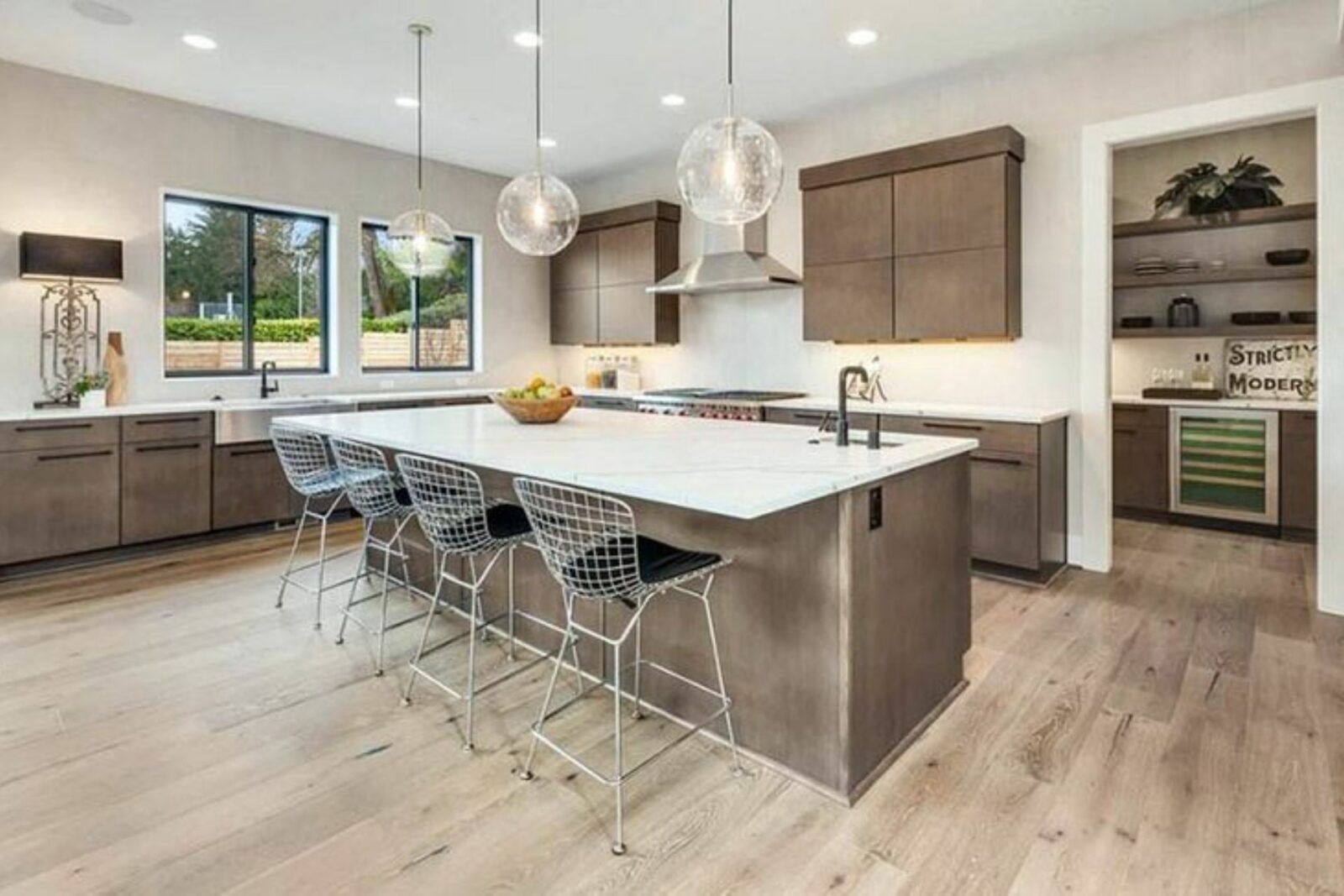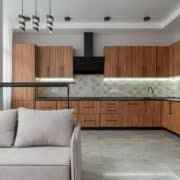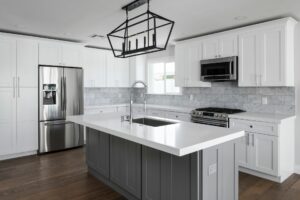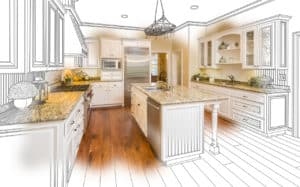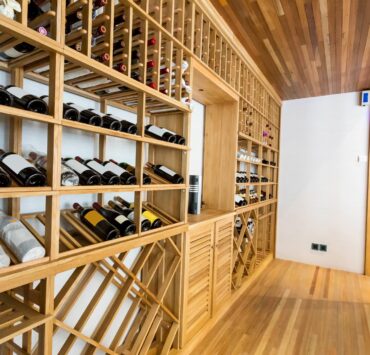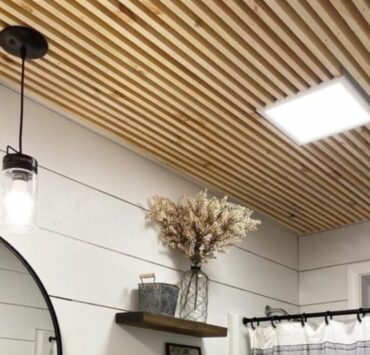Creating a kitchen that seamlessly combines practicality and aesthetic appeal is a delicate balance.
Among the varied kitchen layouts available, the L-shaped kitchen with an island shines through with its superior functionality, versatility, and sophisticated style.
This comprehensive guide delves into every aspect of this particular kitchen design, elaborating on its advantages, considerations, and essential design tips.
Understanding the L-Shaped Kitchen with Island Layout
An L-shaped kitchen layout is precisely as its name suggests – the arrangement of countertops along two adjoining walls creates an “L” shape. This layout is particularly advantageous as it makes efficient use of corner space, reducing the need for excessive movement during meal preparation.
The versatility of this layout is one of its key selling points. Whether you’re dealing with a compact apartment kitchen or a more spacious open-plan home kitchen, the L-shaped layout can be easily adapted to fit various kitchen sizes and dimensions.
The Benefits of an L-shaped Kitchen with Island
Efficient Use of Space
The L-shaped kitchen layout is a masterclass in efficient space utilization. The configuration frees up wall space, making room for an open floor plan, which not only lends a sense of spaciousness but also reduces the likelihood of traffic flow problems. The layout also provides ample room for appliances and storage, contributing to the overall functionality of the kitchen.
Enhanced Functionality
The L-shaped layout naturally complements the concept of the kitchen work triangle, a design principle that connects the stove, refrigerator, and sink – the three main work areas in any kitchen. By strategically placing these areas in close proximity, the L-shaped layout optimizes workflow efficiency, reduces the steps needed for meal preparation, and minimizes clutter.
Flexibility in Design
The L-shaped kitchen layout is like a blank canvas – it readily accommodates a wide range of design styles. Whether your aesthetic leans towards contemporary minimalism, classic traditionalism, rustic farmhouse, or chic modernity, the L-shaped layout can adapt to your preference. This flexibility makes it a universally appealing choice for homeowners with varying tastes.
Incorporating an Island into Your L-Shaped Kitchen L-Shaped Kitchen with Island
Adding an island to an L-shaped kitchen can dramatically enhance its functionality and aesthetic appeal. However, it’s crucial to weigh the benefits against the potential drawbacks to make an informed decision.
Pros of Adding an Island
An island can significantly elevate the functionality and visual appeal of your L-shaped kitchen. Here are some compelling benefits:
- Additional Workspace: An island provides an extra countertop space for meal preparation, serving, and even for casual dining.
- Extra Storage: Islands typically come equipped with cabinets and drawers, offering additional storage space for your cookware, utensils, small appliances, and other kitchen essentials.
- Informal Seating Area: An island can double as a casual dining spot or a place for social interaction during meal prep, making your kitchen a more communal space.
- Social Hub: An island can act as a central hub during social gatherings, enabling the cook to engage with guests while preparing meals, thereby fostering a more interactive and inclusive environment.
Cons of Adding an Island
Despite the many benefits, there are potential downsides to adding an island that you should consider:
- Space Requirements: An island requires a substantial amount of floor space. In a small kitchen, an island could create a cramped feel and disrupt the ease of movement.
- Potential Obstruction: If not properly planned, an island can impede the workflow in your kitchen, particularly in the work triangle. It’s crucial to consider the placement of the island carefully to ensure it doesn’t hinder functionality.
- Higher Costs: Incorporating an island can add to your kitchen renovation costs. Additional cabinetry, countertop materials, and potential plumbing or electrical work for appliances or outlets are factors that could increase your overall budget.
Design Tips for L-Shaped Kitchen with Island
Plan Your Layout Carefully
Space planning is one of the most critical aspects of kitchen design. It’s important to ensure that there’s enough clearance between the island and the countertops to facilitate easy movement. A gap of at least 42 inches is typically recommended. Also, consider the placement of appliances, ensuring that doors can open freely without obstruction.
Choose Your Materials Wisely
The choice of materials can significantly influence the longevity, maintenance, and aesthetic appeal of your kitchen. For countertops, materials such as granite, quartz, or solid surface offer a balance of durability and visual appeal. Cabinetry finishes can range from natural wood to painted or laminated surfaces, depending on your preference. For the backsplash, ceramic or glass tiles are easy to clean and come in various styles. Flooring should be durable, easy to clean, and slip-resistant, with options like ceramic tiles, hardwood, and luxury vinyl being popular choices.
Optimize Storage
In an L-shaped kitchen with an island, there’s an ample opportunity to maximize your storage space. Use a mix of cabinets and drawers for varied storage needs. Consider pull-out drawers for easy access, carousel units for corner cabinets, and overhead storage racks for pots and pans. Utilize the island for additional storage – it’s perfect for larger items or things you don’t use daily. Also, don’t forget about vertical space – installing open shelves or hanging racks can provide additional storage without taking up floor space.
Install Proper Lighting
Lighting is a crucial aspect of kitchen design. It ensures safety during meal prep and contributes to the overall ambiance. Consider a combination of ambient, task, and accent lighting. Recessed lights or track lighting can provide general illumination, under-cabinet lights can offer task lighting for meal prep, and pendant lights above the island can serve as both task and accent lighting, providing illumination for tasks and adding a design element to your kitchen.
Consider the Island’s Function
Before finalizing the design for your island, think about its main function. If you plan to use it for cooking or cleaning, you might want to install a cooktop, sink, or dishwasher. If it’s primarily for dining or working, ensure it has comfortable seating and ample legroom. The functionality of your island should cater to your specific needs to make the most of your kitchen space.
Keep Consistent with Your Design Style
While the island is often the centerpiece of the kitchen, it should still complement the overall design of the room. From the choice of cabinetry and countertop to the seating and lighting fixtures, strive for a cohesive look that makes your kitchen appear well-planned and harmonious.
Adding Personality to Your L-Shaped Kitchen with Island
Your kitchen should reflect your personality and taste. Here are a few ways to add a personal touch:
Choose a Unique Island Countertop
The island often serves as the focal point in an L-shaped kitchen, so make it stand out. Choose a countertop material different from the rest of your kitchen. For example, if you have stone countertops elsewhere, consider a butcher block or concrete countertop for the island.
Add Color to your L-Shaped Kitchen with Island
Don’t shy away from adding color to your kitchen. This could be in the form of colorful cabinets, a bright backsplash, or even vibrant bar stools at your island. You could also consider a statement color for your island to make it stand out.
Display Your Collections
If you’re a fan of vintage cookware, have an impressive collection of cookbooks, or love to display your glassware, find a way to showcase these in your kitchen. Open shelves or glass-front cabinets are perfect for displaying your collections. Not only does this allow easy access to your items, but it also personalizes your kitchen and makes it uniquely yours.
Future-proofing Your L-shaped Kitchen with Island
As you invest time, energy, and resources into redesigning your kitchen, it’s worth considering how your needs might change in the future. Here are a few tips for future-proofing your kitchen:
Invest in Quality
While it might be tempting to save on certain elements, investing in high-quality materials and appliances can pay off in the long run. For instance, opting for durable countertops and cabinetry, high-efficiency appliances, and long-lasting lighting fixtures can save you from frequent replacements and repairs.
Consider Universal Design
The principles of universal design ensure that your kitchen is accessible and functional for people of all ages and abilities. Features like a variable-height island, pull-out pantry, wide walkways, and lever-style handles on faucets and doors can make your kitchen more versatile and future-proof.
Plan for Technological Integration
As we move further into the digital age, kitchens are becoming more technologically advanced. Whether it’s smart appliances, integrated charging stations, or voice-activated lighting and music, plan for these possibilities when designing your kitchen. Including these elements now could save you from costly and disruptive renovations in the future.
The L-shaped kitchen layout with an island is not just a passing design trend; it’s a timeless, practical design that optimizes space, enhances workflow, and can be customized to suit any style preference. As with any design project, thoughtful planning, careful material selection, and attention to detail are crucial to creating a kitchen that is not only beautiful but also functional and comfortable to use for years to come. Remember that your kitchen is the heart of your home, and its design should reflect your lifestyle, taste, and needs.
